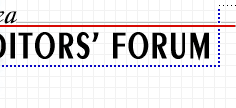
 |
|
||||||||
 |
Editorial Services Guide
By The Bay Area Editors' Forum
| Development |
| Manuscript Preparation and Design |
| Production |
| Stages of Publishing: Manuscript Preparation and Design | |
| Traditional Stages | Digital Technology's Impacts |
At this stage, a series of editors (overseen by a project or production editor or a copy chief) prepares the manuscript for production. Their goal is to minimize the number of changes necessary later, because making changes once the text and visuals are laid out is more costly and increases the likelihood of errors in the final product. Each editor checks the previous editor's work and/or inspects the manuscript for consistency, accuracy, and other issues determined by the nature of the project. A project or production editor also drives the design process by writing a design survey--an analysis of the manuscript's elements, on which the designer bases the design and specs--and codes the manuscript for typesetting or formatting. The designer bases design samples on representative portions of manuscript and on art specs. Participation The manuscript preparation and design stage may require the following kinds of editorial expertise:
Other participants at this stage may include a designer and a photo researcher. |
Online editing speeds up manuscript preparation and design and makes heavy editing easier. Features such as spell checking and search-and-replace operations make it easier to ensure accuracy and consistency in a manuscript. However, editors and proofreaders not used to working online may need time to get used to reading text on screen; they may initially miss more errors than they would on paper. An additional consideration is that not all online editing methods leave an editing trail that makes it possible to trace the author of a particular change. On interactive media projects, an information designer may work with a writer to develop design specs. |
home |
find the right editor |
membership |
about us
what do editors do? |
next forum |
forum index
editing resources |
contact us |
search
© 1997–2025 Bay Area Editors' Forum. All rights reserved.
~~ Responsive CSS (beta) ~~